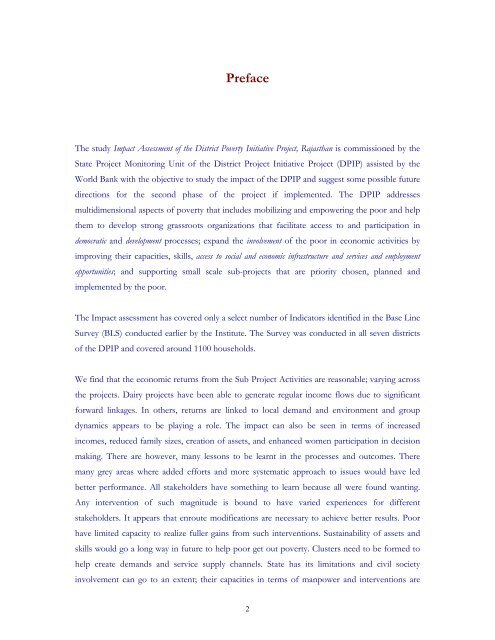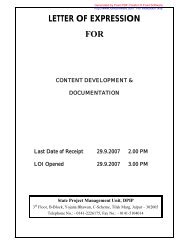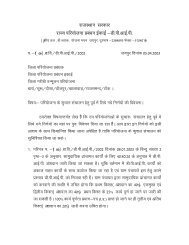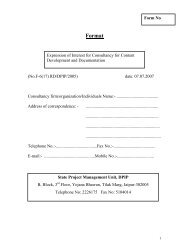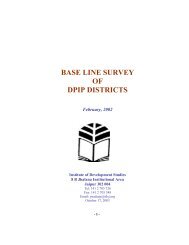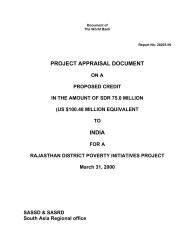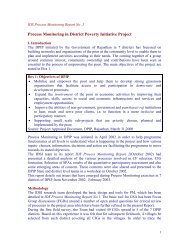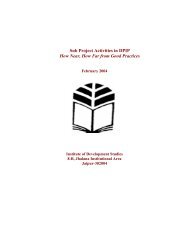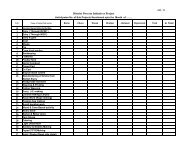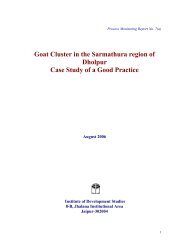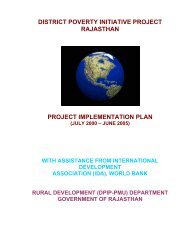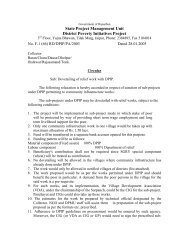Impact Assessment of the District Poverty Initiative Project Rajasthan
Impact Assessment of the District Poverty Initiative Project Rajasthan
Impact Assessment of the District Poverty Initiative Project Rajasthan
Create successful ePaper yourself
Turn your PDF publications into a flip-book with our unique Google optimized e-Paper software.
Preface<br />
The study <strong>Impact</strong> <strong>Assessment</strong> <strong>of</strong> <strong>the</strong> <strong>District</strong> <strong>Poverty</strong> <strong>Initiative</strong> <strong>Project</strong>, <strong>Rajasthan</strong> is commissioned by <strong>the</strong><br />
State <strong>Project</strong> Monitoring Unit <strong>of</strong> <strong>the</strong> <strong>District</strong> <strong>Project</strong> <strong>Initiative</strong> <strong>Project</strong> (DPIP) assisted by <strong>the</strong><br />
World Bank with <strong>the</strong> objective to study <strong>the</strong> impact <strong>of</strong> <strong>the</strong> DPIP and suggest some possible future<br />
directions for <strong>the</strong> second phase <strong>of</strong> <strong>the</strong> project if implemented. The DPIP addresses<br />
multidimensional aspects <strong>of</strong> poverty that includes mobilizing and empowering <strong>the</strong> poor and help<br />
<strong>the</strong>m to develop strong grassroots organizations that facilitate access to and participation in<br />
democratic and development processes; expand <strong>the</strong> involvement <strong>of</strong> <strong>the</strong> poor in economic activities by<br />
improving <strong>the</strong>ir capacities, skills, access to social and economic infrastructure and services and employment<br />
opportunities; and supporting small scale sub-projects that are priority chosen, planned and<br />
implemented by <strong>the</strong> poor.<br />
The <strong>Impact</strong> assessment has covered only a select number <strong>of</strong> Indicators identified in <strong>the</strong> Base Line<br />
Survey (BLS) conducted earlier by <strong>the</strong> Institute. The Survey was conducted in all seven districts<br />
<strong>of</strong> <strong>the</strong> DPIP and covered around 1100 households.<br />
We find that <strong>the</strong> economic returns from <strong>the</strong> Sub <strong>Project</strong> Activities are reasonable; varying across<br />
<strong>the</strong> projects. Dairy projects have been able to generate regular income flows due to significant<br />
forward linkages. In o<strong>the</strong>rs, returns are linked to local demand and environment and group<br />
dynamics appears to be playing a role. The impact can also be seen in terms <strong>of</strong> increased<br />
incomes, reduced family sizes, creation <strong>of</strong> assets, and enhanced women participation in decision<br />
making. There are however, many lessons to be learnt in <strong>the</strong> processes and outcomes. There<br />
many grey areas where added efforts and more systematic approach to issues would have led<br />
better performance. All stakeholders have something to learn because all were found wanting.<br />
Any intervention <strong>of</strong> such magnitude is bound to have varied experiences for different<br />
stakeholders. It appears that enroute modifications are necessary to achieve better results. Poor<br />
have limited capacity to realize fuller gains from such interventions. Sustainability <strong>of</strong> assets and<br />
skills would go a long way in future to help poor get out poverty. Clusters need to be formed to<br />
help create demands and service supply channels. State has its limitations and civil society<br />
involvement can go to an extent; <strong>the</strong>ir capacities in terms <strong>of</strong> manpower and interventions are<br />
2


